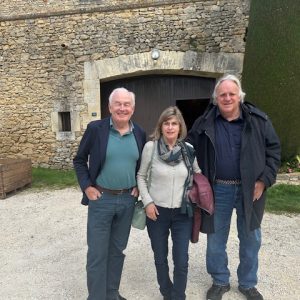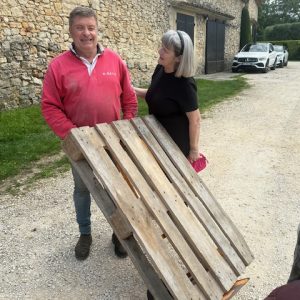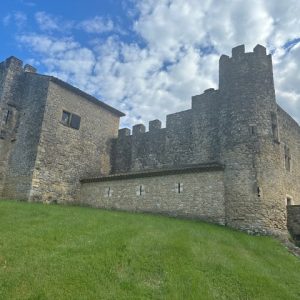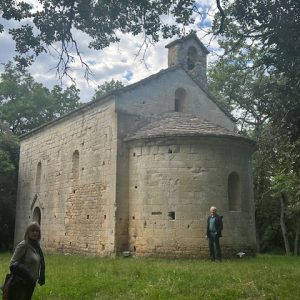Château de Boussargues
It’s not that long ago that Côtes Du Rhône wines had a poor reputation. De la piquette – perhaps “plonk” in English. That did not apply of course to great Rhone wines like Châteauneuf-du-Pape, Côte-rôtie or Hermitage.
But today things are changing. Oenology, science and technology, and a younger generation of winemakers means that Côtes Du Rhône wines can be very good. One such example is Château de Boussargues, which is now making wines of excellent quality.
Château de Boussargues (Colombier Sabran) is most certainly worth a visit, as I did recently with my good friends, John and Benedict. The arrival at Château de Boussargues is spectacular. Lush vineyards, nestled into the landscape, with a beautiful backdrop of wooded hills on the other.
We could instantly smell the history oozing out of the landscape and buildings. The site was apparently occupied following the arrival of the Romans two millennia ago, who established a villa devoted in part to viticulture because of its exceptionally sunny aspect.
The fall of Rome in 476, the collapse of the Roman Empire and the barbarian invasions marked the end of the “pax romana” and the return of insecurity. Old villas were abandoned or fortified. This seems to have been the case at Boussargues where progressively the villa gave way to a medieval castle which became the new heart of agricultural exploitation.
The erection of the present buildings started in the 12th century and continued into the 15th century bringing about the replacement of older fortifications. The lordship of Boussargues then passed into the hands of the Knights Templar at that time lords of Sabran.
Over the years, the Château de Boussargues fell into a deep sleep and the castle, abandoned by its soldiers and its lord, threatened ruin. It was Chantal Constant-Malabre who took over the family estate in the 1960s. She undertook colossal restorations.
Her son Olivier restructured the winery, inherited from Roman antiquity and which, despite the vagaries of history, has always survived. With its two hundred hectares, the Château de Boussargues bears witness to a prestigious history.
Before we attacked the wine tasting Olivier pushed us to visit a small chapel up on the hill behind the vineyard and winery. This sumptuous Romanesque chapel, dating from the 12th century, is a mystical treasure hidden in the forest.
This chapel is classed today as a historic monument where one can admire the magnificent Roman frieze which comprises its interior cornice and of which one also finds fragments on the façade.
A little breathless on our return to the winery, we accepted Olivier’s invitation to taste some red, white and rose wines. The reds and roses were roughly an even blend of mainly black Grenache and Syrah grapes, with smaller proportions of Cinsault, Carignan and Counoise. The whites were a blend of White Grenache, Clairette and white Uni.
For my money, these wines were of very good quality, and make nice easy drinking wines. Well balanced, nicely structured with a good equilibrium of fruit, acid and tannin. Moreover, these wines offer excellent value for money. I bought June a magnum of red, mainly for novelty value. But John reassured me that he finds the magnum wine to be of superior quality.





